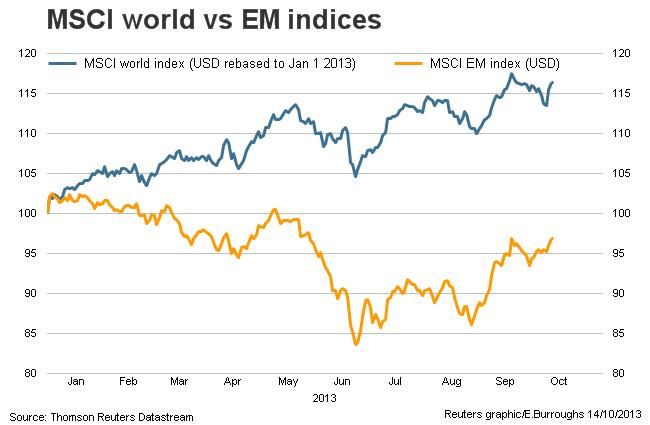
Divyang Shah, IFR Senior Strategist
When it comes to the outlook for emerging markets two risks remain on the horizon:
1) an eventual Fed taper, and
2) the China slowdown story.
EM has benefited from relief on both fronts for EM but both will remain a challenge during 2014.
While the environment for EM is more challenging, some are fundamentally better placed than others to weather the Fed/China storm clouds.
Even before the Fed delivered its no-taper surprise, the EM world had seen a return of confidence on both EM and DM stock markets. While the S&P 500 managed to make a new record high, the MSCI-ex Japan index remained below its May 2013 peaks (see chart).
The inability of what has traditionally been a high-beta play on global growth highlights the challenges that remain. After all, the Fed has simply delayed an eventual tapering, and the China slowdown story remains shrouded in uncertainty.
The US government shutdown and the lack of data releases have further complicated the tapering outlook, which is now increasingly looking like it will start once Yellen has taken over as chairwoman, perhaps at the first meeting in March.
The data on China have eased some fears about a hard landing, but the latest IMF forecast - cutting GDP forecasts to 7.6% for 2013 (down 0.2 percentage points) and 7.3% for 2014 (down 0.4 percentage points) - highlights the downside risks.
We get more significant data releases from China this Friday in the form of Q3 GDP, IP, investment and retail sales to provide another opportunity to gauge growth risks. With Q3 GDP expected to come in at 7.8% from 7.5% in Q2, the market will be comfortable in viewing the hard landings as still less likely. Growth meandering below/around 7.5% remains likely as China’s policy makers are biased toward smart fiscal stimulus and a desire not to allow monetary policy to further boost credit growth.
Since May we have seen a divergence in performance between those EM with c/a deficits and c/a surpluses. Further differentiation is likely within the EM universe with a key focus being the extent to which countries have relied on credit growth to boost economic performance. The one area of real EM concern is how unconventional policy from major central banks and portfolio inflows helped to promote a credit and housing bubbles in many Asian countries.
We are still in the early stages of seeing the excess credit growth story play out in some of these countries.
